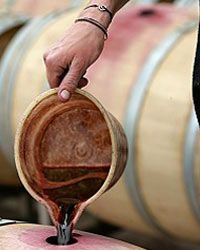If you've ever dreamed of owning a vineyard, or even if you just really like to drink wine, you've probably envisioned the winemaking process to look something like this: You fling open the French doors of your Tuscan villa (wait, shouldn't those be Italian doors?) and gaze fondly at a terraced hillside with row after row of grapevines as far as the eye can see. You stroll into the vineyard, carefully harvesting grapes and placing them lovingly into the basket cradled on your arm. Back on your stone patio, you slip off your shoes and crush the grapes between your toes in a wooden tub passed down from your grandfather (never mind that he was born in Hoboken and wouldn't know a wine grape from a blueberry). Then you strain the crushed grapes into an oak barrel, some sort of special magic happens, and before you know it, you are pouring a glass of your award-winning creation with friends as you gather around a rustic farm table in the fading golden sunlight.
Of course, back here in the real world, the winemaking process bears little resemblance to this fantasy. Grapes are harvested, crushed and processed with the help of sanitized and sophisticated equipment, and winemakers add specially formulated ingredients in precise quantities to give each wine its own distinctive quality and taste. So what exactly goes into your favorite wine? It's sometimes hard to know, since vintners aren't required to list their ingredients on wine labels, but most modern wines include at least a few extras in addition to those all-important grapes.
Advertisement
Whether you're thinking about making your own wine or just curious about what went into the last bottle you opened, read on to get the rundown on 10 common wine additives.



